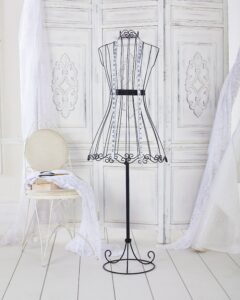Fashion industry in Nigeria is a vibrant and diverse reflection of the country’s rich cultural heritage, blending traditional styles with contemporary trends.
Fashion Industry
The fashion industry in Nigeria plays an important cultural role and contributes significantly to the country’s economy.
In Nigeria, clothing is not just a means of covering the body but a powerful form of self-expression. Traditional Nigerian attire varies across the country’s numerous ethnic groups, each boasting distinct styles, fabrics, and colors. For instance, the Yoruba people are known for their Aso-oke fabric, often used in crafti
 ng elaborate outfits for special occasions, while the Igbo people may showcase their unique George wrappers and blouses.
ng elaborate outfits for special occasions, while the Igbo people may showcase their unique George wrappers and blouses.
One iconic Nigerian garment is the Ankara fabric, characterized by vibrant patterns and bold colors. Originally associated with West African countries, Ankara has become a global fashion phenomenon. Nigerian designers have skillfully incorporated Ankara into modern fashion, creating stylish dresses, skirts, and blouses that celebrate both tradition and modernity.
The Nigerian fashion industry scene is not only rich in traditional wear but has also embraced Western styles, creating a unique fusion. Nigerian designers have gained international acclaim for their creativity and innovation. Brands like Deola Sagoe, Lisa Folawiyo, and Mai Atafo have made significant contributions to the global fashion landscape, showcasing the talent and originality emanating from Nigeria.
Nigerian fashion extends beyond clothing to encompass accessories and hairstyles. Gele, the elaborately tied headgear, is a staple in Nigerian women’s fashion, adding an extra layer of elegance to their attire. Additionally, intricate beadwork and jewelry are often incorporated to complement and enhance the overall look.
In recent years, the Nigerian fashion industry has witnessed a surge in fashion events and shows, with Lagos Fashion Week standing out as a prominent platform for designers to showcase their collections. These events not only serve as a stage for local designers but also attract global attention, promoting Nigeria as a fashion-forward nation.
Social media has played a pivotal role in amplifying Nigerian fashion on a global scale. Instagram, in particular, has become a hotspot for showcasing fashion trends, styles, and individual expressions. Nigerian influencers and fashion enthusiasts leverage these platforms to share their unique takes on style, influencing trends both locally and internationally.
Furthermore, the rise of e-commerce has facilitated the accessibility of Nigerian fashion to a global audience. Many Nigerian designers and brands now have online stores, allowing fashion enthusiasts worldwide to explore and purchase authentic Nigerian pieces with ease.
The Nigerian government takes the initiative by providing a more suitable environment for nigeria fashion and textile businesses to thrive, it could be a way to rebuild the once thriving industries on a national scale. Decades ago, the country had a relatively booming textile sector, but like most other areas, progress died down with the oil boom. Coupled with the Chinese takeover, the industry came to a complete stop.
Reviving the sector is possible, particularly with introducing new policies and improving credit solutions to creative industries. Furthermore, investment in infrastructure and demographic data would help fashion businesses to understand and serve their markets better. The government’s mistake of neglecting the sector in the past stemmed from the idea that it was not viable. International markets and even markets closer to home, such as Ethiopia, have proven otherwise.
The sector has an incredible chance at growth if managed strategically. Furthermore, if the industry is invested purposefully and sustainably, it has incredible potential to empower many individuals and, in the long run, vastly improve the Nigerian economy.
By getting our house in order, Nigeria can take advantage of global economic dynamics. Many businesses have shut down in recent years, buckling under the pressure of high infrastructure costs, low consumer demand, and an unstable currency.
Yet there are slight green shoots of a manufacturing revival in the country. The Nigerian Ministry of Industry, Trade and Investment launched a ‘Nigeria Industrial Revolution’ plan to build the manufacturing GDP in industries such as textile and automobile assembling, amongst many others. Within the last two years, capacity utilisation has grown from 29% to 50%, with nearly 8,000 jobs created. This has made it easier for brands such as Maki O and Ize to source locally-made fabrics such as Adire, Aso-oke, and Oja.
In addition, Nigeria fashion may be able to attract foreign direct investment. On a recent visit to China, three out of nine manufacturers I visited were setting up shop in Northern Nigeria, encouraged by the support for the textile industry provided by Governor Abdullahi Ganduje in Kano State. In 2017, Kano State signed a Memorandum of Understanding with a Chinese firm to build a $600 million textile industrial park. Although there have been no visible effects of Ganduje’s policies, even tacit government support can be vital in securing the confidence of international investors.
China has been one of the leading global exporters of clothing and textiles since the 90s, holding 40% of the global market share. Still, rising costs of production and changing economic dynamics (from investment-led manufacturing to services-led consumption) have encouraged some manufacturers to look abroad. The best example is Ethiopia, which China is looking to as a manufacturing hub, pouring billion dollars’ worth of investment and expertise into the East African nation. In the same vein, if Nigeria can address some of its infrastructural and governance challenges, it will have a low-cost environment and labour force to accommodate a similar economic experiment.
In conclusion, Nigerian fashion is a dynamic and evolving narrative that beautifully weaves together tradition and modernity. The fusion of traditional ethnic wear with contemporary styles, the global success of Nigerian designers, and the influential role of social media have collectively positioned Nigeria as a significant player in the global fashion arena. The nation’s unique fashion landscape continues to captivate audiences, making a lasting impact on the diverse and ever-changing world of style.
